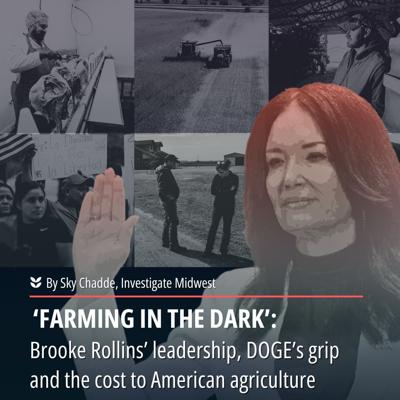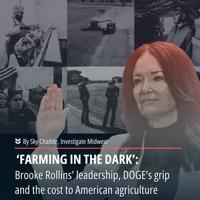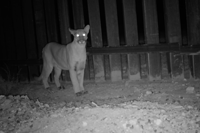
Brooke Rollins believes she is waging a new American Revolution, leading a crusade against Biblical darkness and guiding U.S. agriculture into a “golden age.”
In her first six months as the nation’s top agriculture official, Rollins has reshaped the U.S. Department of Agriculture’s focus — “more farmer, less climate,” she summarized. Her leadership will make farmers more prosperous than ever before, she proclaimed.
“This is making America and American agriculture great again,” she told Congress.
But her management has left many within USDA unmoored and frightened. Mass firings have purged scientists, whose discoveries underpin modern agriculture, from seeds to soil management. Indiscriminate terminations will likely deter younger, qualified candidates from joining the effort to address agriculture’s pressing challenges, such as adapting to climate change and containing animal diseases like bird flu.
Rollins-approved funding freezes and cancellations have squeezed small farmers and risked their trust. Rural communities could be kneecapped: Rollins has proposed cutting resources for broadband initiatives and Rural Development, the agency that invests in farmers’ communities.
The divestment of staff, science and sustainability programs at USDA isn’t just a budget cut; it could be a direct threat to the nation’s food system. Experts warn of far-reaching consequences: unsafe food for consumers, more invasive and economically damaging pests for farmers, and an agriculture industry forced to adapt to climate change with less scientific insight.
“We might see more farming in the dark, essentially,” said Michal Happ, a climate change and rural community expert at the Institute for Agriculture and Trade Policy.
Investigate Midwest spoke with multiple agricultural experts and more than 30 current and former USDA employees to better understand Rollins’ leadership style, her impact on the department and the profound consequences her administration will have for farmers, rural families and consumers.
What emerged was a picture of a leader who has brought sweeping changes and largely embraced President Trump’s agenda of downsizing the federal government. However, Rollins has also been tasked with managing Trump policies that she has privately rebuked and cuts made before she assumed office.
Trump tapped Rollins to head the massive federal department at a crucial time for American agriculture. Farmers are grappling with changing weather patterns, shifting trade policies, and even internal administration critiques of pesticide use — a report from Health Secretary Robert Kennedy Jr.’s “Make America Healthy Again” commission, which Rollins applauded, slammed farms’ pesticide reliance.
Trump has praised Rollins’ performance. In mid-April, as an aside during a press conference, Trump thanked her for lowering egg prices. “Brooke Rollins, secretary of agriculture, did a great job,” he said. During his first term, she maneuvered into his inner circle and, as Politico reported, has quickly become “one of the most powerful conservatives in the country.”
Rollins has said her mission is to be the voice of farmers in Trump’s cabinet. She appears to have pull with the president, but questions remain about her influence over decisions affecting the USDA and its staff.
Elon Musk’s Department of Government Efficiency, or DOGE, appeared to wield significant control over department operations, at least until recently. It influenced everything from policy language to which USDA offices remain open, according to court records and Rollins’ hearing testimony.
In a statement to Investigate Midwest, the USDA rejected any characterization that Rollins was not solely responsible for department actions.
“The claims you cite are absurd and without merit,” it said. “Secretary Rollins was appointed by President Trump to lead the Department and to insinuate that anyone other than the Constitutionally directed cabinet officer is making the decisions at USDA is unwarranted.”
She’s also been sandwiched between Trump’s signature policy, an extreme stance on immigration, and the reality of agriculture’s labor force.
Because of immigration raids, some farms’ labor pools have been depleted, and, already, some fields have not been harvested. Farmers have pleaded for relief. In early June, Rollins pushed Trump to pause enforcement on farms, The New York Times reported. After the news broke, Rollins proclaimed she was in lockstep with Trump.
Raids on farms resumed days later, but Trump recently expressed support for giving farmers discretion over undocumented workers.
“Brooke Rollins brought it up, and she said, ‘So, we have a little problem. The farmers are losing a lot of people,’ and we figured it out, and we have some great stuff being written,” he said during a July 4 speech.
On July 8, Rollins said undocumented farmworkers would receive “no amnesty.”
Farming is inherently risky. Making a living depends on good weather and profitable markets. Farmers try to limit variables, but Rollins’ first months have added disorder into the food system, said Mike Lavender, a policy expert for the National Sustainable Agriculture Coalition.
“All of it is this theme of creating needless uncertainty and confusion amongst people who are trying to do the exact opposite in order to be successful in their livelihoods, support their families and ultimately support their communities,” he said.
The USDA did not directly answer questions about Rollins’ tenure, and, in a statement, it said she was cleaning up a mess left by her predecessor, Tom Vilsack.
“Secretary Rollins is working to reorient USDA to put Farmers First and be more effective and efficient at serving the American people,” the department said. “President Biden and Secretary Vilsack left USDA in complete disarray, including hiring thousands of employees with no sustainable way to pay them.”
In congressional hearings, Rollins said the USDA, which has lost more than 15,000 employees, has enough staff to fulfill its mission. Trump’s desire to make new deals with trading partners — which is causing confusion and financial anxiety for farmers — will create stability for agricultural producers, Rollins has said.
“I do believe, with every fiber of my being, that this era of unlimited or unprecedented prosperity for the ag community is just around the corner,” Rollins told Congress in June. “I’m just really, really sure of that.”
Rollins has painted the present as being “strikingly similar” to the time of the American Revolution, a period she often invokes in speeches. She has also cast her leadership in Biblical terms, citing Romans 13:12, saying she wears an “armor of light” in her current position.
“There is just a lot of darkness — not with this White House or my current boss, President Trump, or our cabinet, but the government in general,” Rollins told Decision Magazine, a religious publication, during an interview last month.
The USDA did not answer when asked if Rollins views rank-and-file employees as part of the “darkness.” But her management of employees varies drastically from her two predecessors, Vilsack and Sonny Perdue, Trump’s first agriculture secretary.
Perdue was a veterinarian and, as governor of Georgia, had led a large bureaucracy, experience that translated into running a complex federal department in a “thoughtful, analytical way,” said Kevin Shea, a USDA employee for 45 years under Republican and Democrat administrations.
“The first Trump administration at USDA was run very professionally,” Shea said. Now, however, “the USDA political leadership seems to be particularly scornful of its career workforce.”
For instance, very little information filters down to employees. Leadership has not effectively communicated what it wants, so it’s been a “gradual process of learning what is and is not OK,” said Ethan Roberts, president of AFGE Local 3247, a union representing government employees, and a nine-year USDA employee.
Agency staff used to plan months or years ahead, but that’s difficult now because they don’t know if they’ll still have jobs or if the office will exist, said one current employee who requested anonymity for fear of reprisal.
Her two predecessors regularly sent department-wide emails that communicated their goals and priorities, current and former employees said. Rollins seems to have a different audience in mind.
“She just posts on X what she’s doing,” said Laura Dodson, the vice president of AFGE Local 3403 and a longtime USDA employee. X, the social media company owned by Musk, requires an account to view posts. “It just seems everything’s coming from DOGE and whatever the White House is saying about federal employees.”
The first Trump administration also instituted funding freezes and reduced staff, including relocating USDA offices out of Washington, D.C. One of the affected agencies was the Economic Research Service, which provides insights into markets the industry relies on.
In 2019, Dodson and her colleagues were called into a conference room. If their job description was called, they would remain where they had established their lives. The others, the vast majority, would be relocated to Kansas City, Missouri. Employees started crying.
Despite that episode from Trump’s first term, Dodson said, the tone of his second stint is markedly different as DOGE, overseen by Musk until May, has wantonly carved up federal agencies.
“They still maintained a veneer of respectability. They were trying to do this for the greater good,” she said about the USDA under Perdue. “Now, with people like Elon Musk, it’s clear this is not the pursuit of efficiency. It’s the pursuit of cruelty.”
DOGE slashes a scared staff
Before Rollins was sworn in, DOGE and USDA’s new political appointees began slashing.
Budget officers received a flowchart instructing them to block any money from the Inflation Reduction Act or the Infrastructure Investment and Jobs Act, two major economic infusions during the Biden presidency, The New York Times reported. Judges have ruled the freezes illegal.
Officials, including new chief of staff Kailee Buller, submitted plans for mass firings to Musk’s quasi-governmental organization, court records show. DOGE thought it needed reworking. Then, on Feb. 13, Buller met with Noah Peters, a DOGE operative in the White House. Buller “shared her experiences terminating the employees ‘cause that process was underway at Agriculture,” Peters said.
Rollins took over that night, and, the next day, thousands received termination notices. When Congress pressed her on the mass firings, Rollins shifted responsibility. “That happened before I was sworn in,” she said.
While job cuts and funding freezes were pursued, there appeared to be little knowledge of the USDA’s work.
For instance, school nutrition researchers were told to flag any studies that included the word “class” — an attempt to discover funding for diversity, equity and inclusion, a Trump target, said one employee who asked for anonymity for fear of reprisal.
Another time, DOGE’s main liaison to the USDA, Gavin Kliger, requested that the word “tracking” be added to the list of words to flag in grants that could be terminated, according to an email included in a lawsuit.
“Tracking the exact carbon output of soybean yields does not provide a direct benefit to farmers,” he reasoned in an email to staff, “and we can reallocate that funding in a way that more directly benefits farmers.”
Kliger’s LinkedIn resume does not show any experience in agriculture. He graduated from the University of California-Berkeley in 2020 and has worked exclusively for tech and artificial intelligence companies. He has helped slash staff and funding at other agencies, including the Consumer Financial Protection Bureau.
It’s unclear how he came to this understanding about carbon tracking.
Carbon is essential to soil health, producing higher yields. Knowing how much carbon is escaping their soil can help farmers adopt better soil management techniques. This not only helps farmers grow more efficiently but helps keep the plant from warming. Soy industry groups have expressed the importance of tracking carbon footprints.
Also, under a Biden-era rule, measuring carbon output helps put money directly in farmers’ pockets — they can sell their output on carbon offset markets.
Despite this misguided reasoning, Kliger appears to have had considerable influence at the USDA.
In the same email, he said he wanted to surpass DOGE’s goal of cutting $120 million in climate-focused grants by a certain date. “I spoke with the Secretary tonight who was supportive of these initiatives – working on getting a memo formalized for her signature in parallel,” he wrote.
Kliger did not respond to requests for comment to his USDA email address. The USDA did not respond when asked about the email or how much influence Kliger had.
“All decisions made at the USDA are at the direction of secretary Rollins to best fulfil (sic) president trumps (sic) agenda,” the department said.
Kliger appears to have moved on. The USDA said his access to the National Finance Center, which manages employee payroll, has been “deactivated due to lack of use. … We would refer you to” the Small Business Administration.
While voices with no agricultural experience have been elevated, those with expertise — USDA employees — have been pushed aside and silenced, current and former employees said.
One skirmish between DOGE and the USDA’s rank-and-file has involved the Trump administration’s return-to-office policies. Some Republican leaders and Musk have claimed that allowing employees to work remotely is a waste.
In 2020, the COVID-19 pandemic forced remote work for staffers at the Farm Service Agency, which helps farmers access federal funding. As the year progressed, Perdue, the agriculture secretary at the time, considered calling workers back to the office.
However, an internal study found that employees had actually been more efficient, said Charles Dodson, a 30-year FSA veteran who retired late last year.
Despite that, Trump ordered remote workers back to offices when he retook the presidency. At the same time, DOGE began canceling leases of local offices around the country.
At a May hearing, members of Congress accused Rollins of being unaware that local FSA offices were being closed. Rollins did not deny the accusation. Then at a June hearing, she said the General Services Administration, a DOGE target, was behind the closures. (Some offices have since reopened.)
On the ground, the situation has caused confusion and consternation for USDA employees.
When one employee reported to a new office, they were told they weren’t on the list of transfers. How could they follow the order to report to an office if they weren’t allowed in? Another USDA employee, a researcher, was ordered to report to a Forest Service trailer in the woods. And another employee, according to NPR, was told to report to a shed where a boat was stored.
The USDA has also intimidated its workforce, current and former employees said.
According to Roberts, the department veteran and union representative, USDA scientists have been instructed to deflect questions from university researchers — their frequent collaborators — about the agency’s internal affairs.
“They’re being told to say those things for fear it looks like the USDA is silencing them,” he said, “which they are.”
Surveillance also has increased. While the government has used software to monitor employee emails for years, the Trump administration has altered it to detect emails sent to a personal or college account. As part of a leak investigation, one staffer was placed on administrative leave after emailing their personal account, even though it did not contain the leaked material officials were looking for.
The USDA did not respond to a question about the leak investigation.
Some employees have responded by doing only what is asked of them, not going above and beyond. Dodson, the retiree, recounted what a current staffer told him: “I’m afraid to do anything else. I just want to survive and not get fired.”
Navigating agriculture’s latest challenges
In May, after thousands had been forced to leave the USDA, Rollins reassured Congress the department had adequate staffing to perform its mission. For instance, she said, no one from the Animal and Plant Health Inspection Service, or APHIS — which includes veterinarians and staff battling invasive diseases and pests — had left.
They were “key, critical components,” she said.
The comment shocked APHIS employees. Two weeks earlier, several hundred employees who helped keep pests out of the U.S. accepted the administration’s deferred resignation offers, which would pay them to not work for months. (Some returned after the offers were rescinded.)
Overall, roughly 15% of APHIS’s 8,000 employees have departed following the administration’s attempts to cut headcount, according to DTN. That includes about 400 from the agency’s Plant Protection and Quarantine division, which keeps invasive species out of the U.S., and about 350 veterinarians, said Shea, the longtime USDA employee who was the agency’s leader under Presidents Obama, Trump and Biden.
The cuts will have a ripple effect, particularly during emergencies, he said. To respond, employees will be moved from their regular duties, leaving others to pick up the slack.
The lack of staff is a major obstacle, Shea said.
“There couldn’t be a worse time to lower our guard,” he said. “APHIS cannot do its job with that level of personnel. It simply cannot do it. I’ve never been more concerned about the agency’s ability to carry out its mission going forward.”
The USDA has implemented a hiring freeze, but in April it exempted APHIS. The agency has posted job listings online.
“Secretary Rollins will not compromise the critical work of the Department,” the USDA said. The exempted positions “carry out functions that are critical to the safety and security of the American people, our national forests, the inspection and safety of the Nation’s agriculture and food supply system.”
Another challenge Rollins has faced is trade, the lifeblood of U.S. agriculture.
When Trump returned to office, he generated chaos in the agricultural markets by starting a trade war and implementing higher tariffs. In response, Rollins has embarked on a global tour to establish new trade partners.
She has announced a few “Make Agriculture Great Again trade wins.” She recently proclaimed that Namibia, an African country, agreed to accept frozen poultry from the U.S. The Biden administration had opened the market after allaying the country’s concerns about bird flu. Also, she declared Costa Rica accepting U.S. dairy a win for Trump. An industry trade group said the “win has been several years in the making.”
Rollins has said repeatedly that the agricultural trade deficit — the U.S. imports more products from overseas than it exports — is bad for the country. The tariffs were intended to address the deficit, but the narrative hit a snag in early June.
Politico reported the USDA had delayed a regularly scheduled report because it showed Trump’s tariffs could exacerbate the trade deficit. Days later, Rollins defended the delay. “I want to be sure every piece of research we move out is the best, the best-cited, etc.,” she told Congress. (The hearing was about a week after news broke that the MAHA report, which Rollins supported, cited nonexistent studies.)
Perhaps the most pressing issue facing Rollins is helping the agriculture industry as it grapples with climate change, which is altering how farmers grow food and commodities. Rollins, however, has denied the planet is warming.
Her husband is an executive at an oil and gas company, and in a 2018 speech, she said “research of CO2 being a pollutant is just not valid,” according to Inside Climate News. More recently, she led the America First Policy Institute, which pushes Trump’s agenda. She employed another Trump loyalist, Carla Sands, who once said the idea of climate change is “Marxism to control humanity,” according to Politico.
In January, before Rollins was sworn in, USDA employees were directed to “unpublish any landing pages (on the USDA’s website) focused on climate change,” according to court records. Research involving climate change has also been effectively banned, current employees said. If studies include words such as “climate,” “clean energy,” “sustainable construction” or dozens of others, the research will not be funded.
Climate change is having profound effects on agriculture. For instance, the Corn Belt — considered the prime region for growing the valuable commodity used in everything from soft drinks to gasoline — is inching northward. In decades, instead of Iowa and Illinois, Minnesota and the Dakotas could be America’s breadbasket, researchers have predicted.
More recent research shows that, as the world keeps warming and farming gets harder, U.S. corn production could fall by 40% by century’s end.
If the USDA ignores climate issues, farmers could be struggling alone, said Happ, of the Institute for Agriculture and Trade Policy.
“They want to adapt to what’s going on,” he said. “They want to still have their land there and steward it for the next generation or two. Without those resources, they’re going to just have to figure it out on their own.”
The USDA did not respond when asked about Rollins’ household’s financial stake in fossil fuels. At a congressional hearing, Rollins agreed with a representative who said sound policy follows sound science. The USDA did not respond when asked why the USDA was not following climate change science.
Promises of healthy food waylaid
In March, Rollins cancelled more than $1 billion in funding that paid small farmers to supply fresh meat and produce to schools and food banks. Supporters of the initiatives — named the Local Food for Schools and Child Care and Local Food Purchasing Assistance programs — said they helped local economies and supplied nutritious meals to growing kids.
In a Fox News appearance, Rollins argued the funding was non-essential because it was a COVID-era program. The funding has helped farmers in most states, according to the USDA’s website.
Nullifying those programs undercut another initiative of the Trump administration, the MAHA push to castigate processed foods and promote healthy products, said Debbie Friedman, with the Food Insight Group, which studies food system infrastructure. At the press conference releasing the MAHA report, Rollins referred to herself as a “MAHA mom.”
“While the MAHA concept is terrific,” said Friedman, specifically referencing its stance on improving the food supply, “the action steps they’re taking are the exact opposite. It’s all talk.”
Rollins has also overseen a divestment in food safety research.
The USDA has forced out 98 of 167 food safety scientists at the Agricultural Research Service, a department arm that studies how to prevent deadly pathogens, such as E. coli or Salmonella, from entering the food supply.
Foodborne illnesses could become more prevalent because the work the scientists were doing will likely just end, said Roberts, the union representative who works for the Agricultural Research Service.
“Who knows what we’ve lost? What discoveries or products that were going to be invented that we’ll just never see?” Roberts said. “We’ll be stuck with the tools we have now.”
A robust food safety system, with research and vigilant monitoring, is necessary to help prevent foodborne illnesses, which not only can hospitalize consumers but also have long-lasting health consequences, said Barbara Kowalcyk, a longtime food safety researcher who is now at George Washington University. In a 2013 study, Kowalcyk and her colleagues showed foodborne infections could lead to, among other conditions, chronic kidney disease, arthritis and cognitive deficits.
An example of science and government oversight working in concert to save lives stems from a deadly outbreak in the 1990s, she said. After eating undercooked hamburgers at Jack in the Box, more than 700 people fell ill and four children died.
The scandal put the USDA’s food safety system under an intense microscope, and the department changed how it protected America’s meat supply. Instead of eyeing and smelling a carcass, the USDA began testing for pathogens, a monumental task to implement.
The original testing procedure was first developed in the 1960s and refined over the decades. Since the USDA’s Food Safety and Inspection Service began using the system — named Hazard Analysis and Critical Control Point — cases of foodborne illness from beef have declined dramatically.
“Lots of effort went into that,” Kowalcyk said. “We don’t see the same level of outbreaks in ground beef that we used to.”
Rollins plans on altering the USDA’s, and the country’s, future through her actions. Cutting funding to farmers, axing scientists, instilling fear in remaining employees — it’s about changing the country’s course.
“It isn’t just about the next four years,” she told Breitbart in May. “It’s about the next 250 years.”
But it could all backfire on farmers, rural communities and consumers, said Lavender, with the national sustainable agriculture coalition.
“The draining of expertise at USDA,” he said, “whether that’s scientific expertise or just expertise of people who have been there for a period of time and have built up knowledge — it will ultimately come home to roost.”










(0) comments
Welcome to the discussion.
Log In
Keep it Clean. Please avoid obscene, vulgar, lewd, racist or sexually-oriented language.
PLEASE TURN OFF YOUR CAPS LOCK.
Don't Threaten. Threats of harming another person will not be tolerated.
Be Truthful. Don't knowingly lie about anyone or anything.
Be Nice. No racism, sexism or any sort of -ism that is degrading to another person.
Be Proactive. Use the 'Report' link on each comment to let us know of abusive posts.
Share with Us. We'd love to hear eyewitness accounts, the history behind an article.